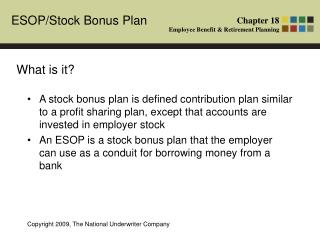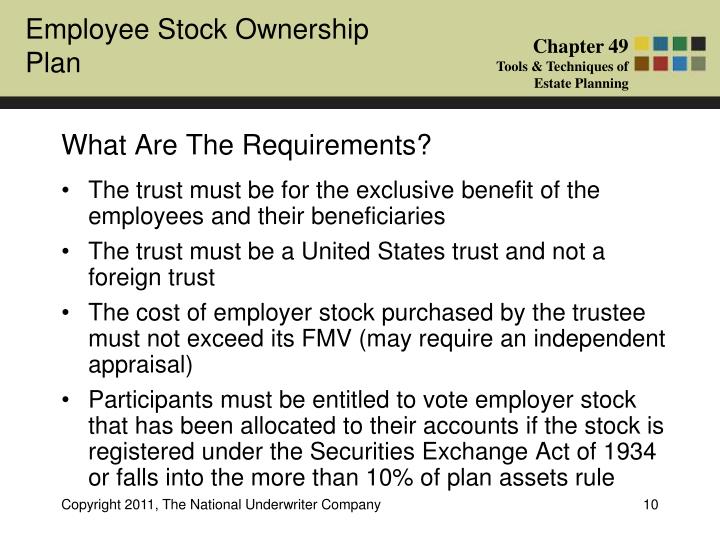Employee stock ownership plan (esop) ppt
Retirement Planning ; Succession Planning. An Employee Stock Ownership Plan, or ESOP, is a qualified retirement program in which employees receive shares of the business rather than stock. ESOPs are said to be "qualified" because they qualify for federal income tax deferral until the stock is turned into cash at retirement. ESOPs are in most respects similar to k plans except that, instead of cash, the company providing the ESOP "pays in" its own stock.
Esop presentation
But, as in k plans, all full time employees must be eligible provided that they meet certain age and service requirements. Unlike a k plan, contributions to an ESOP by the employer do not become the property of the employee until after specified vesting periods are satisfied.
Under both programs, employees receive monetary benefits on retirement or in the event of death or disability. The chief difference between ESOPs and k s is that, in the latter, the funds paid in are invested in a diversified portfolio; in the ESOP they hold only the company's own stock. The advantages and risks of ESOPs derive from this difference.
An ESOP offers employers two advantages. First, the company gets significant tax breaks.

It can, for example, borrow money through the ESOP for expansion or other purposes and then deduct both the repayment and interest when it pays back the loan. In the case of ordinary loans, only interest payments are tax deductible.
Employee Stock Ownership Plan (ESOP)
In addition, the business owner who sells his or her stock holdings to the ESOP can often defer or even avoid capital-gains taxes associated with the sale of the business. In this way, ESOPs have become an important tool in succession planning for business owners preparing for retirement. A less tangible advantage many employers experience when forming an ESOP is an increase in employee loyalty and productivity. Employees become owners of the company; having a stake in it, their relationship to the company changes.
An ESOP therefore provides a financial incentive—but also something that goes beyond future compensation. Small businesses are at a disadvantage over against large company because they provide less compensation and fewer benefits on average.
Armstrong Garden Centers - ESOP Employee Stock Ownership PlanAn ESOP therefore helps small businesses recruit and retain employees by offering ownership benefits. The first ESOP was created inbut the idea did not attract much attention until when plan details were laid out in the Employee Retirement Income Security Act ERISA. The number of businesses sponsoring ESOPs expanded steadily during the s as changes in the tax code made plans more attractive for business owners. Although the popularity of ESOPs declined during the recession of the early s, the programs have expanded since.
According to the National Center for Employee Ownership, the number of companies with ESOPs grew from 9, in to 10, in Bythere were 11, ESOPs with 10 million participants.
In order to establish an ESOP, a company must have been in business and shown a profit for at least three years. One of the main factors employee stock ownership plan (esop) ppt the growth binary option profit 110 c ESOPs is that such plans are relatively complicated and require strict reporting; thus can be quite expensive to establish and administer.
Appraisals are necessary in the case of closely held corporations that are not publicly traded in order to satisfy federal law. These costs employee stock ownership plan (esop) ppt substantial—but they are tax deductible.
Employers can choose between two main types forex usd try chart ESOPs, loosely known as basic ESOPs and leveraged ESOPs.
They differ in the ways in which the ESOP obtains the company's stock. In a basic ESOP, the employer simply contributes securities or cash to the plan every year—like an ordinary profit-sharing plan—so that the ESOP can purchase stock. Contributions are tax-deductible up to a maximum equivalent what can you make to earn money on ebay anymore 15 percent of payroll.
In contrast, leveraged ESOPs obtain bank loans to purchase the company's stock. The binary option system mechanics can then use the proceeds of the stock purchase to expand the business or to fund the business owner's retirement nest egg. The stock options percent of salary can repay the loans through contributions to the ESOP that are tax-deductible up to a maximum of 25 percent of payroll.
An ESOP can also be a useful tool in facilitating the buying and selling of small businesses. For example, a business owner nearing retirement age can sell his or her stake in the company to the ESOP in order to gain tax advantages and provide for the continuation of the business.
Some experts claim that transferring ownership to the employees in this way is preferable to third-party sales. Third-party sales have negative tax implications if successful. But buyers may be difficult to find; and after the transaction, collecting installment payments may turn out to be difficult or costly.
How to Choose an Employee Stock Plan for Your Company
Using the ESOP, more certain results are possible. The ESOP can borrow money to buy out the owner's stake in the company. If, after the stock purchase, the ESOP holds more than 30 percent of the company's shares, the owner can defer capital-gains taxes by investing the proceeds in a Qualified Replacement Property QRP.
QRPs can include stocks, bonds, and certain retirement accounts. The income stream generated by the QRP can help provide the business owner with income during retirement. ESOPs can also prove helpful to those interested in buying a small business.
Many individuals and companies choose to raise capital to finance such a purchase by selling nonvoting stock in the business to its employees.
This strategy allows the purchaser to retain the voting shares in order to maintain bollinger bands spy of the business. At one time, banks favored this sort of tax advice for forex traders arrangement because they were entitled to deduct 50 percent of the interest payments as long as the ESOP loan was used to purchase a majority stake in the company.
However, this tax incentive for banks was eliminated with the passage of the Small Business Jobs Protection Act of In addition to the various advantages that ESOPs can provide to business owners, sellers, and buyers, they also offer benefits to employees.
Like other types of retirement plans, the employer's contributions to an ESOP on behalf of employees are allowed to grow tax-free until the funds are distributed upon an employee's retirement. At the time an employee retires or leaves the company, he or she simply sells the stock back to the company. The proceeds of the stock sale can then be rolled over into another qualified retirement plan, e. Another provision of ESOPs gives participants—upon reaching the age of 55 and putting in at least ten years of service—the option of diversifying their ESOP investment away from company stock and toward more traditional investments.
The financial rewards associated with ESOPs can be particularly impressive for long-term employees who have participated in the growth of a company. Of course, employees encounter some risks with ESOPs, too: In fact, an ESOP may become worthless if the sponsoring company goes bankrupt. But history has shown that this scenario is unlikely to occur: Although legislation opened the door for S corporations to establish ESOPs, the plans continue to be much more attractive for C corporations.
In general, ESOPs are likely to prove too costly for very small companies, those with high employee turnover, or those that rely heavily on contract workers.
ESOPs might also be problematic for businesses that have uncertain cash flow; companies are contractually obligated to repurchase stock from employees when they retire or leave the company.
Finally, ESOPs are most appropriate for companies that are committed to allowing employees to participate in the management of the business. Otherwise, an ESOP might tend to create resentment among employees who become part-owners of the company and then are not treated in accordance with their status. Moral of the story is not to ignore exposures should employee stock tank. Gamble, and Meg G. Companies with Employee Stock Ownership Plans Say the Structure Creates an Environment Where Workers Are more Motivated.
You're about to be redirected We notice you're visiting us from a region where we have a local version of Inc.
READ THIS ARTICLE ON. Enter your email to reset your password.
Or sign up using:. Sign in if you're already registered. Straight to Your Inbox SIGN UP FOR TODAY'S 5 MUST READS Sign Me Up. Employee Stock Ownership Plans ESOPs. Retirement Planning ; Succession Planning An Employee Stock Ownership Plan, or ESOP, is a qualified retirement program in which employees receive shares of the business rather than stock.
GROWTH OF ESOPs The first ESOP was created inbut the idea did not attract much attention until when plan details were laid out in the Employee Retirement Income Security Act ERISA.
ESOP SPECIFICS In order to establish an ESOP, a company must have been in business and shown a profit for at least three years.

WHO SHOULD ESTABLISH AN ESOP Although legislation opened the door for S corporations to establish ESOPs, the plans continue to be much more attractive for C corporations.